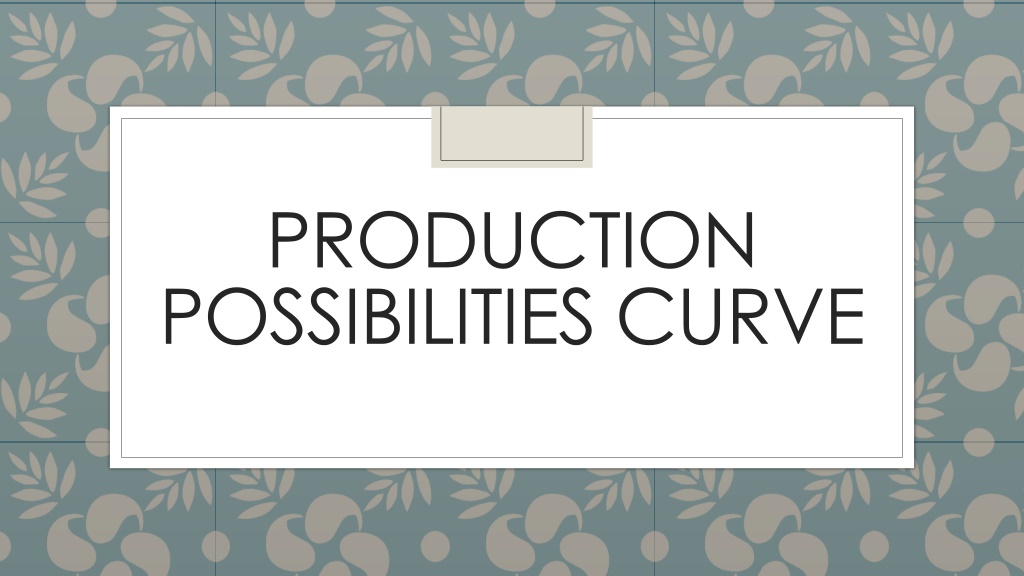Understanding Production Possibilities Curve and Economic Growth
Explore the concept of the production possibilities curve, including its assumptions, implications of being under or beyond the curve, types of opportunity costs, shifts in the curve, and the impact of economic growth on a nation's productivity and output capacity.
Download Presentation

Please find below an Image/Link to download the presentation.
The content on the website is provided AS IS for your information and personal use only. It may not be sold, licensed, or shared on other websites without obtaining consent from the author. Download presentation by click this link. If you encounter any issues during the download, it is possible that the publisher has removed the file from their server.
E N D
Presentation Transcript
PRODUCTION POSSIBILITIES CURVE
4 Assumptions of the Model 1.Full Employment 2.Fixed Resources 3.Fixed Technology 4.Two Goods
UNDER or BEYOND the Curve UNDER the curve is attainable by the modeled economy but not efficient. Unemployment, idle resources* BEYOND the curve is unattainable with current resources.
Constant Opportunity Cost Curve is a straight line constant slope. Ex- red/blue m&ms, squares and triangles
Shifts in the Production Possibility Curve Society can produce more output if: Technology is improved. More resources are discovered. Economic institutions get better at fulfilling our wants.
Economic GrowthEconomic growth results in The economy can now produce more of everything. A (20 fish and 25 coconuts), it can move to point E (25 Production is initially at point an outward shift of the PPF because production possibilities are expanded. fish and 30 coconuts).
Economic Growth Illustrated both in overall performance, or by sector. Overall = both intercepts increase Sector = one variable of production increases, one intercept increase Result from new technology, improved labor, or more capital
Shifts in the Production Possibility Curve Neutral Technological Change Butter C A 0 Guns D B
Shifts in the Production Possibility Curve Biased Technological Change Butter C B 0 Guns A
Fish and Fruit PPC Fish 12 10 8 6 4 2 Fruit 30 5 10 15 20 25
Combinations 9 fish and 13 fruit Attainable 10 fish and 13 fruit Unattainable 7 fish and 18 fruit Attainable
Maximum Efficiency 11 fish and 0 fruit Efficient Efficient 10 fish and 7 fruit 4 fish and 20 fruit NOT Efficient
Movies and Books PPC Movies 1. What is the opportunity cost to moving from point A to point B? 2. What is the opportunity cost of moving from point C to point B? 3. What does point Z represent? 1000 800 A 600 B 400 C Z 200 D 200 Books (per month) 1000 40 0 600 800
Production Possibilities Curve: Capital Goods and Consumer Goods Suppose a new government comes into power and forbids the use of automated machinery and modern production techniques in all industries. Which curve in the diagram would represent the new production possibilities curve? the new production possibilities Suppose massive new sources of oil and coal are found within the economy, and there are major technological innovations in both industries. Which curve in the diagram would represent Suppose there is a major technological breakthrough in the consumer-goods industry, and the new technology is widely adopted. Which curve in the diagram would represent the new production possibilities curve? curve?
Shifts along the Curve 1. What would cause the production possibilities curve to shift from the original curve (XX ) to the new curve (YY )? 2. Why might a government implement policy to move the economy from Point B to Point A?
1) Which of the following would not shift an economy's PPC? a) An increase in population. b) Doubling the amount of capital in the economy. c) An increase in the money supply. d) A technological advance. 2) Efficiency along the PPC implies, a) Goods are produced quickly. b) The state of technology is maximized. c) In order to get more of a good, some of another must be given up. d) Goods are distributed equitably. 3) A PPC shows, a) The best combination of goods to produce. b) The plans for increasing output in the short run. c) What can be produced with various combinations of resources. d) Resources are constrained by choices. 4) An economy has a constant cost PPC. What do you know about the slope? a) A straight line. b) Bowed in. c) Bowed out. d) Convex to origin.
5) What determines the opportunity cost along a PPC? a) The kinds of goods being produced. b) The slope of the PPC. c) Choices made by the economy. d) The area under the PPC. 6) Which of the following are assumptions underlying the PPC? a) Only two goods are produced. b) Technology, population, and capital are variable. c) Prices determine the position on the PPC. d) All the above. 7) What statement below implies that a PPC will be an increasing cost curve? a) Resources are scarce. b) Most resources are more productive in certain uses than others. c) Underemployment of productive resources. d) Diminishing marginal returns to scale.























